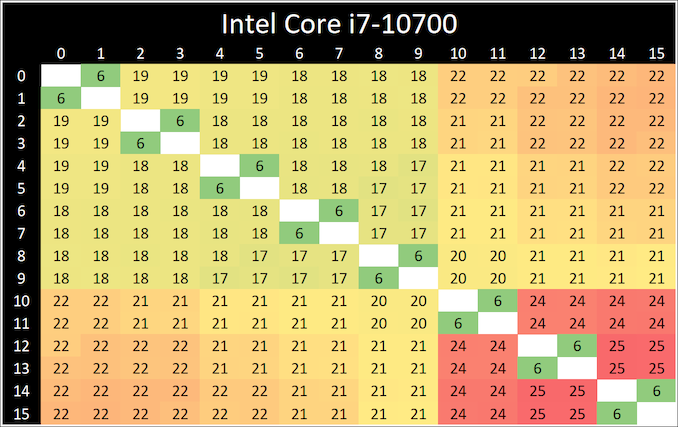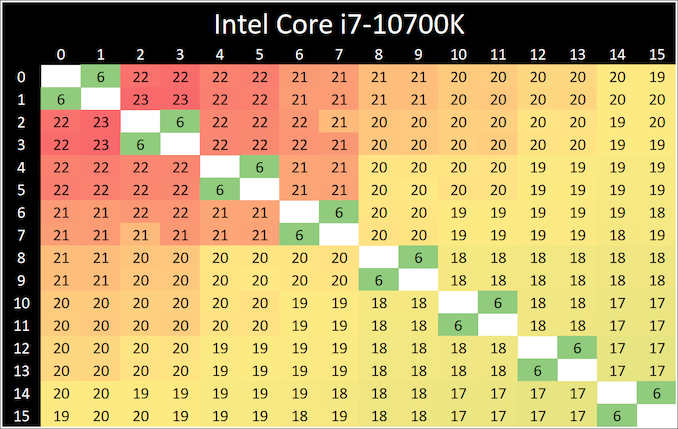Intel Core i7-10700 vs Core i7-10700K Review: Is 65W Comet Lake an Option?
by Dr. Ian Cutress on January 21, 2021 10:30 AM EST- Posted in
- CPUs
- Intel
- Core i7
- Z490
- 10th Gen Core
- Comet Lake
- i7-10700K
- i7-10700
CPU Tests: Microbenchmarks
Core-to-Core Latency
As the core count of modern CPUs is growing, we are reaching a time when the time to access each core from a different core is no longer a constant. Even before the advent of heterogeneous SoC designs, processors built on large rings or meshes can have different latencies to access the nearest core compared to the furthest core. This rings true especially in multi-socket server environments.
But modern CPUs, even desktop and consumer CPUs, can have variable access latency to get to another core. For example, in the first generation Threadripper CPUs, we had four chips on the package, each with 8 threads, and each with a different core-to-core latency depending on if it was on-die or off-die. This gets more complex with products like Lakefield, which has two different communication buses depending on which core is talking to which.
If you are a regular reader of AnandTech’s CPU reviews, you will recognize our Core-to-Core latency test. It’s a great way to show exactly how groups of cores are laid out on the silicon. This is a custom in-house test built by Andrei, and we know there are competing tests out there, but we feel ours is the most accurate to how quick an access between two cores can happen.
When we first reviewed the 10-core Comet Lake processors, we noticed that a core (or two) seemed to take slightly longer to ping/pong than the others. These two parts are both derived from the 10-core silicon but with two cores disabled, and we still see a pattern of some cores having additional latency. The ring on the 8-core parts still acts like a 10-core ring, but it all depends on which cores were disabled.
Frequency Ramping
Both AMD and Intel over the past few years have introduced features to their processors that speed up the time from when a CPU moves from idle into a high powered state. The effect of this means that users can get peak performance quicker, but the biggest knock-on effect for this is with battery life in mobile devices, especially if a system can turbo up quick and turbo down quick, ensuring that it stays in the lowest and most efficient power state for as long as possible.
Intel’s technology is called SpeedShift, although SpeedShift was not enabled until Skylake.
One of the issues though with this technology is that sometimes the adjustments in frequency can be so fast, software cannot detect them. If the frequency is changing on the order of microseconds, but your software is only probing frequency in milliseconds (or seconds), then quick changes will be missed. Not only that, as an observer probing the frequency, you could be affecting the actual turbo performance. When the CPU is changing frequency, it essentially has to pause all compute while it aligns the frequency rate of the whole core.
We wrote an extensive review analysis piece on this, called ‘Reaching for Turbo: Aligning Perception with AMD’s Frequency Metrics’, due to an issue where users were not observing the peak turbo speeds for AMD’s processors.
We got around the issue by making the frequency probing the workload causing the turbo. The software is able to detect frequency adjustments on a microsecond scale, so we can see how well a system can get to those boost frequencies. Our Frequency Ramp tool has already been in use in a number of reviews.
Both processors ramp from idle to full turbo in about six milliseconds, well within a single frame of standard gaming.













210 Comments
View All Comments
HarkPtooie - Saturday, January 30, 2021 - link
Noteworthy points:It is an i7-10700F
On a Gigabyte B460M
Populated with 4x16 GB DDR-3000
With an ancient Quadro K2000 and an NVMe SSD.
Hyperthreading is disabled.
I use it for running FEA simulations aside my Ryzen workstation, and it performs like a champ. The cheap&old wattmeter hoovers around 157 W or so during simulations. 100% CPU load.
So I take it that if I got the Z490, the CPU would draw 60W more. Would it go faster?
Qasar - Saturday, January 30, 2021 - link
as Spunjji said Harkptooie, practically every review out there, says the opposite of what you are.so, who is correct then ?
HarkPtooie - Sunday, January 31, 2021 - link
Oh, they do? Be a sport and link me to all those reviews.TechPowerUp puts it at 2W above the 3700X at stress test.
https://www.techpowerup.com/review/intel-core-i7-1...
Annnnd... that's it. The rest I find are all "compare" sites listing numbers culled from manufacturer sites.
And here comes Anandtech and tells me that my eyes are deceiving me and that my CPU is actually pulling twice as much as I am observing.
The explanation of which would be that better mobos have a power setting that allows it to draw much more than default, with no obvious benefits? I don't get it.
Everett F Sargent - Sunday, January 31, 2021 - link
Well, now you are almost there. Wherever there is. that is.Watts (power) * Time (seconds) = Energy (e. g. kWh) used
Power (W) versus frequency (Hz) is highly nonlinear (concave up and more so the closer you get to the redline). Your cooling solution can only dissipate so much power per unit time in 247 continuous operation, at a low enough core temperature.
This is all really basic stuff.
So, it will take longer to complete a fixed task at 125W then that same fixed task at 250W (all other things being equal), wherein the first task is running at 4GHz and the 2nd task is running at 5Ghz. These are only example numbers btw.
That TechPowerUp review has plenty of fixed task benchmarks (on the other pages) wherein the total time (in seconds) is given. You might want to check out those pages also.
They use four settings on a Z490 MB. The one that is closest to the out-of-box MB tests mentioned here is their "The third data point (blue bar) sees us relaxing the power limits to enable the maximum turbo frequency available for this processor." or what those bar charts are labeled as "Core i7-10700 Max Turbo" ...
It is a real shame that more sites don't do thorough enough reviews. So, for example, on this review on the 2nd page ...
https://images.anandtech.com/doci/16343/10700KInte...
That is a fixed time test and not a fixed task test. That should have been explained in this review.
Maybe this site will do better next time, by using a low end out-of-the-box MB in addition to their high end out-of-the-box Z490 MB. Report frequency, power, energy and time for all tests/tasks. Use proper recording of all these to get a more complete picture of what the heck is going on (time series and integrals thereof even).
My formal and informal (or on the job) training in doing scientific experiments goes back almost fifty years now. Not that that means anything on the internet. :/
Qasar - Sunday, January 31, 2021 - link
HarkPtooie toms hardware, gamers nexus, redgamingtech, moores law is dead. all pretty much say intel uses more power then amd. in some cases, quite a bit more.so either you have your system set up differently, and are forcing it to use the power it does, and the rest, let the board run as it see's fit, as you said : The explanation of which would be that better mobos have a power setting that allows it to draw much more than default, with no obvious benefits? I don't get it. " actually there is a benefit, when intel's cpus are allowed to use as much power as it can and wants, the performance goes up.
but what ever, you believe what you want.
HarkPtooie - Monday, February 1, 2021 - link
Yes, they do - but they do not say that the i7-10700 non-K uses twice the power of an equivalent Ryzen. That is exclusive to this article, and the explanation is that here they use "boost max all the time" BIOS settings that are not quite the nominal default for this CPU.This is overclocking.
Personally I turn it around and think "I am impressed at the performance Intel managed to squeeze out of this CPU at this power level, considering the process node disadvantage".
I am no fanboy. I usually buy AMD because bang/buck. This time I needed AVX-2 without having to tinker with experimental settings, which is the case with AMD+ANSYS.
HarkPtooie - Monday, February 1, 2021 - link
Ah - so the thing is that my CPU runs default as Intel intended it out of the box, whereas this review uses special motherboard settings that overdrives into a "use any power you need" zone where the max turbo runs all the time?Okay. That would explain things.
That Intel uses more power than AMD is not surprising since there is a substantial difference between 10 nm and 7 nm. And I am well aware that they cheat the numbers to look better - but that does not change the fact that nominally my 10700 draws about as much as my 3700X - and performs more or less equally. A bit faster single-thread, a bit slower multi-thread.
What this review amounts to is "If you reach inside your system and boost the shit out of your i7, it draws much more power than Ryzen." - why not go all the way and overclock them to 6 GHz and shriek about how the Intel draws 800W while the AMD only needs 600W?
Everett F Sargent - Monday, January 25, 2021 - link
What MB are you using and/or can you set PL!/PL2 in your BIOS settings? The article is suggesting that on higher end MB's, or some such, the PL1/PL2 settings are set to infinity or can be changed in the BIOS settings (even on a non-K CPU). PL1 is 125W so it appears that your MB has that limit.Everett F Sargent - Monday, January 25, 2021 - link
OK, made a mistake, the i7-10700 has a PL1 value of 65W and a PL2 of 224W and a PL1 Tau of 28s (those appear to be nominal or default values). Still curious as to the MB and accessible BIOS settings. Also is there any system software to see these settings (e. g. like AIDA64). TIAHarkPtooie - Tuesday, January 26, 2021 - link
I did not set any PL. The systems are default except for the RAM speed with is set by XMP to 3000 and 3200 MHz respectively.Should I interpret it as "during certain settings, the i7 can be made to consume vastly more power than it does by default"? That seems contrived.
All I know is that their power consumptions as measured for the whole system are roughly on par during conditions where incidentally the i7 also outperforms the Ryzen in single-thread applications. It is not a bad CPU.